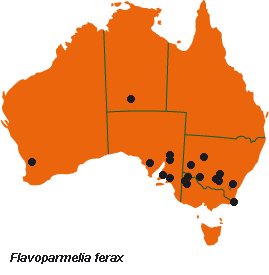



Australian Biological Resources Study
| Checklist of the Lichens of Australia and its Island Territories | ||
| Introduction | A–D | E–O | P–R | S–Z | Oceanic Islands | References | ||
| Flavoparmelia ferax (Müll.Arg.) Hale | ||
| Mycotaxon 25: 604 (1986); Parmelia ferax Müll.Arg., Flora 69: 257 (1886); Pseudoparmelia ferax (Müll.Arg.) Hale, Phytologia 29: 190 (1974). T: near Guntawang, N.S.W., Hamilton 2; lecto: G, fide M.E.Hale, Smithsonian Contr. Bot. 31: 31 (1976). Parmelia obversa Stirt., Trans. & Proc. New Zealand Inst. 32: 76 (1899). T: Riverina, N.S.W., H.Paton s.n.; lecto: GLAM; isolecto: BM, fide M.E.Hale, loc. cit. (1976). | ||
| Thallus adnate, to 5–10 cm wide. Lobes imbricate, elongate, sometimes becoming lobulate, 2–3 mm wide; margins crenulate; apices rotund. Upper surface pale yellow-green, ±rugulose at lobe margins, densely rugose in thallus centre, dull or sometimes slightly shiny, lacking soredia, dactyls and isidia. Medulla white. Lower surface rugulose; rhizines sparse, simple. Apothecia sessile, 2–6 mm wide, crowded in thallus centre; disc concave, cinnamon-brown to dark brown; thalline exciple strongly involute, persistent, becoming rugulose. Ascospores 13–15 × 7–8 µm. Pycnidia common. Conidia fusiform, 9 × 1 µm. CHEMISTRY: cortex K-, UV-; medulla K-, C-, KC-, P+ deep orange; containing usnic acid, physodalic acid (major), conphysodalic acid (minor) and protocetraric acid (trace). |  |
|
| Common, endemic, found on bark, dead wood, and old fence posts in drier areas of southern and central Australia (W.A., N.T., S.A., N.S.W. and Vic.). A misidentified Tasmanian specimen is F. rutidota (Kantvilas et al., 2002). | ||
| Elix (1994g) | ||
| Checklist Index |
| Introduction | A–D | E–O | P–R | S–Z | Oceanic Islands | References |
This work is copyright. Apart from any use as permitted under the Copyright Act 1968, no part may be reproduced by any process without prior written permission from Australian Biological Resources Study. Requests and inquiries concerning reproduction and rights should be addressed in the first instance to Dr P. McCarthy. These pages may not be displayed on, or downloaded to, any other server without the express permission of ABRS.